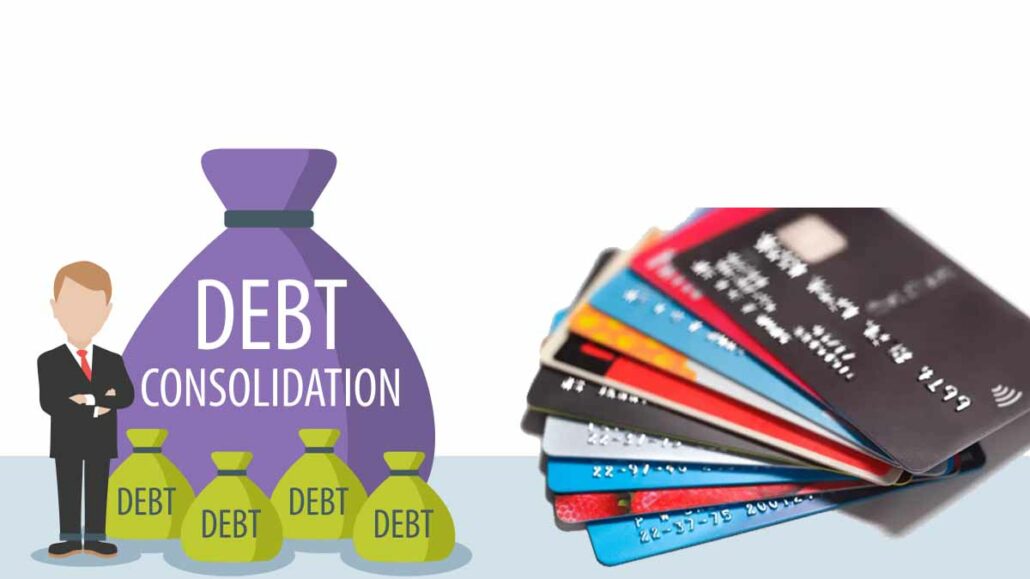Are you drowning in high-interest credit card debt? Feeling overwhelmed managing multiple loan payments? You’re not alone. Millions of people struggle with debt, but there’s a solution: Loan and credit card consolidation. This guide will equip you with the knowledge to tackle your debt strategically and potentially save thousands of dollars.

What is Loan and Credit Card Consolidation?
Consolidation simplifies your debt by combining multiple debts (credit cards, personal loans, etc.) into a single loan with a (ideally) lower interest rate. This simplifies your repayment process with one monthly payment instead of juggling several.
Benefits of Consolidation
Debt consolidation simplifies your financial life by combining multiple debts into a single, lower-interest loan. Here’s how it can benefit you:
- Reduced Interest Rates: Consolidation can secure a lower interest rate than your existing debts, potentially saving you significant money in the long run.
- Simplified Management: One payment simplifies budgeting and reduces the risk of missed payments.
- Improved Credit Score: Lower credit utilization (debt compared to your credit limit) from consolidating can improve your credit score.
- Debt-Free Path: Consolidation offers a clear roadmap to becoming debt-free.
Types of Loan and Credit Card Consolidation
Now that you understand the advantages, let’s explore the different consolidation methods:
Personal Loan Consolidation
This involves securing a personal loan with a lower interest rate than your existing debts. You then use the loan proceeds to pay off your credit cards and other loans, leaving you with a single monthly payment.
Balance Transfer Credit Card
Certain credit cards offer introductory periods with 0% APR on balance transfers. You can transfer your existing credit card balances to this card, taking advantage of the lower interest rate to pay down your debt faster. However, be mindful of potential balance transfer fees and high APRs that kick in after the introductory period.
Home Equity Loan/Line of Credit (HELOC)
For homeowners with sufficient equity in their property, a HELOC or home equity loan can offer competitive interest rates for debt consolidation. However, this option comes with the risk of losing your home if you fail to repay the loan.
Choosing the Right Consolidation Option
Consider these factors:
- Interest Rates: Compare rates from multiple lenders to secure the lowest rate possible.
- Loan Terms: Evaluate the repayment term (length of the loan) and ensure it aligns with your financial goals.
- Fees: Watch out for origination fees, prepayment penalties, and balance transfer fees associated with some consolidation options.
- Credit Score Requirements: Different consolidation options may have varying credit score requirements.
- Debt Amount: Consider the total amount you owe. Balance transfer cards often have limits that may not be enough for larger debts.
- Repayment Terms: Choose a loan term that allows you to comfortably make monthly payments while paying off your debt within a reasonable timeframe.
Consolidation Process
Once you’ve chosen your consolidation method, here’s a breakdown of the steps involved:
- Gather Information: List all your debts, including outstanding balances, interest rates, and minimum payments.
- Calculate Potential Savings: Utilize online consolidation calculators to estimate potential savings with different consolidation options.
- Compare Loan Offers: Get pre-approved for loans or balance transfer cards from multiple lenders to compare rates and terms.
- Choose the Best Option: Select the consolidation option with the lowest interest rate, manageable monthly payment, and minimal fees that aligns with your financial goals.
- Consolidate Your Debts: Use the new loan or credit card to pay off your existing debts according to the lender’s instructions.
- Develop a Repayment Plan: Create a budget that prioritizes paying off your consolidated debt. Consider the debt snowball/avalanche methods to target specific debts.
Alternatives to Consolidation
- Debt Management Plan: A non-profit credit counseling agency can help create a repayment plan and negotiate lower interest rates with creditors.
- Debt Snowball/Avalanche: These methods prioritize paying off smaller debts first (snowball) or debts with the highest interest rates first (avalanche).
- Negotiate Lower Rates: Contact your credit card issuers directly and try to negotiate lower interest rates on your existing debts.
Remember
- Discipline is Key: Consolidation is a tool, but successful debt payoff requires commitment to your repayment plan.
- Avoid New Debt: Don’t accumulate new debt while consolidating existing debt.
Embrace a Debt-Free Future
Loan and credit card consolidation can be a powerful tool to simplify your debt and potentially save money. By following the strategies outlined in this guide, you can take control of your finances and achieve your debt-free goals.
FAQs on Loan and Credit Card Consolidation
What are the drawbacks of consolidation?
There can be origination fees associated with personal loans, and balance transfer cards often have a balance transfer fee (typically a percentage of the transferred amount). Additionally, using a balance transfer card with a 0% introductory APR requires paying off the balance before the introductory period ends to avoid high regular APR kicking in.
How do I choose the best consolidation option?
Compare interest rates, fees, and loan terms of different lenders and balance transfer offers. Consider the length of the consolidation loan term; a shorter term means higher monthly payments but faster debt payoff.
What happens after I consolidate my debt?
Make sure your old accounts are closed after you pay them off with the consolidation loan or balance transfer. Develop a budget to ensure you can consistently make your monthly consolidation payment and avoid accumulating new debt.
Conclusion
Loan and credit card consolidation can be a valuable strategy to simplify debt management, potentially save on interest, and improve your financial health. However, carefully consider your situation and choose the consolidation option that best suits your needs. If you’re unsure, consult a credit counselor or financial advisor for personalized guidance.

